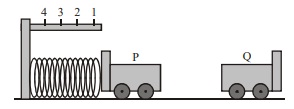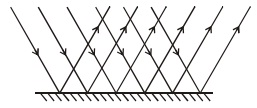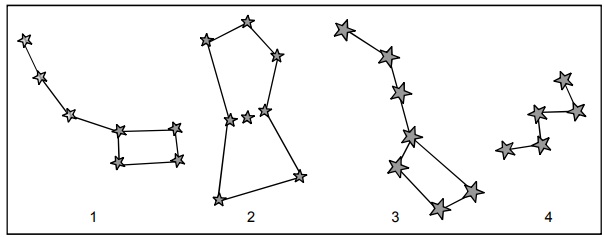TALLENTEX Papers 2021 - Class 9th
Disclaimer: This website is NOT associated with CBSE, for official website of CBSE visit - www.cbse.gov.in
TALLENTEX Papers 2021 - Class 9th
Section - A : Physics
Obejctive
1. When 2 Mirrors are kept at 60o angle, number of observable images formed are :
(1) 5
(2) 6
(3) 4
(4) 3
2. While jumping out from a train of speed 5 km/hr.
(a) We should run in same direction with same speed.
(b) We should gradually retard for stopping.
(c) Jumping in vertical direction will be helpful.
(1) a, b & c
(2) a & c
(3) b & c
(4) a & b
3. The largest planet in group of terrestrial planet is ...........
(1) Earth
(2) Venus
(3) Mars
(4) Mercury
4. Look at the figure showing an experimental setup.

At the start of the experiment, the spring device is compressed to setting number 1 and released to propel the trolley P forward. When trolley P collides with trolley Q, both trolley move together for certain distance. Identify the physical quantities that vary for both trolleys before and after the collision.
(1) Mass, velocity
(2) Mass, momentum
(3) Mass, kinetic energy
(4) Velocity, momentum
5. A spaceship explodes in the space. We do not hear the sound from the explosion because:
(1) Sound may be too weak
(2) Spaceship may be too far
(3) Sound requires medium to travel but there is no medium in space
(4) Sound travels very slow in vacuum
6. Mass and weight of an object on the surface of the earth is 5 kg and 50 N respectively (g = 10 m/s2 on the surface). If this object is taken at the centre of the earth then mass & weight of this object becomes:
(1) 5 kg & 50 N respectively
(2) 5 kg & zero N respectively
(3) Zero kg & 50 N respectively
(4) Zero kg & zero N respectively
7. A body is said to be in equilibrium
(1) If odd number of forces are acting on it.
(2) If even number of forces are acting on it.
(3) If its speed is constant
(4) If its acceleration is zero
8. Which phenomenon is described in the following figure?

(1) Diffused Reflection
(2) Regular Reflection
(3) Irregular Reflection
(4) Zigzag Reflection
9. A particle starts from rest and moves with uniform acceleration. Then the ratio of distance covered in nth sec. to that in n sec. is

10. According to the chart, on which planet would a ball fall the slowest?

(1) Jupiter
(2) Saturn
(3) Neptune
(4) Earth
INTEGER
11. In how many of the following set up, the sound of alarm will be heard by those standing nearby it?

12. A body starts from point A and after covering a distance of 20 m it comes back to the point A. The average velocity of the object (in m/s) is
13. A circket ball of mass 0.1 kg is moving horizontally with a speed of 30 m/s. It strikes a vertical wall and rebounds with a speed of 20 m/s in the opposite direction. The change in momentum of the ball is _ kgm/s.
14. You can easily identify some constellations in the night sky. For this you should know how a particular constellation looks like. One of the most famous constellations which you can see during winter is Orion .Identify Orion from the picture given.

15. From a leak tap, water droplets are constantly falling. It is 11.25 m high. When 1st drop reaches to ground, 4th drop comes out. If the distance between 2nd and 3rd drop at this instant is x meter then calculate the value 100x. (g = 10 m/s2)
16. A car having speed of 6 m/s retards at constant rate of 2 m/s2. calculate the distance trav- elled (in m) in 1 second.
17. How many of the following are the constellations that can be seen in the night sky?
Orion, Ursa Major, Sirius, Ursa Minor, Phobos, Cassiopeia, Polestar
18. An object is thrown downward from an unknown height above the ground with an initial speed of 10 m s–1. It strikes the ground 3.0 s later. What is the initial height (in m) of the object above ground.
19. How many of the following statements are correct?
(i) Mechanical waves need medium for there propagation
(ii) Sound can't travel through vacuum.
(iii) Mechanical waves transport energy from one place to another.
(iv) Sound waves are non-mechanical waves.
20. A car of mass 1000 kg is moving uniformly at 10 ms–1. If the engine of the car develops an extra linear momentum of 1000 kg ms–1, calculate the new velocity (in m/s) with which the car runs?
Click Here For Download Full Paper
Section - B : Chemistry
Objective
21. Which fractional product of petroleum is used as aviation fuel
(1) Naphtha
(2) Kerosene
(3) Gasoline
(4) Diesel
22. Which of the following is not a mixture:
23. Read the given statements and select the correct option
Statement-1 : Non-metals cannot be drawn into thin wire due to absence of malleability.
Statement-2 : Non-metals are brittle in nature.
(1) Both statements 1 and 2 are true and statement-2 is the correct explanation of statement-1.
(2) Both statements 1 and 2 are true but statement-2 is not the correct explanation of statement-1.
(3) Both statements 1 and 2 are false.
(4) Statement-1 is false and statement-2 is true.
24. CO2 is a good fire extinguisher because
(1) It is lighter than O2
(2) It does not support in combustion
(3) It is lighter than H2O
(4) It is also combustible
25. When the blood sample is spin rapidly, the particles are Separated by the technique is -
(1) Centrifugation
(2) Fractional distillation
(3) Evaporation
(4) Tunneling
26. The most inferior quality of coal is:
(1) Lignite
(2) Peat
(3) Bituminous
(4) Anthracite
27. All the noble gases are:
(1) Metals
(2) Non-metals
(3) metalloids
(4) Some are metals and some are non- metals
28. Which of the following metals do reacts with water or dilute acids.
(1) Cu, Ag
(2) Pt, Au
(3) Hg, Ag
(4) Zn, Mg
29. W hich of the following gas is produced after the complete combustion of substance CxHyOZ ?
(1) CO2
(2) N2
(3) O2
(4) CO
30. The conversion of silver articles gel black is called
(1) corrosion and it is a physical
(2) dissolution and it is a physical change.
(3) corrosion and it is a chemical change.
(4) dissolution and it is a chemical change.
INTEGER
31. How many byproducts are obtained directly-indirectly by destructive distillation of coal from the following :-
Ammonia, Nitrogendi-oxide, coke, Napthalene, carbon monoxide, Methane, Sodium bicar- bonate, carbon tetrachloride, Hydrogen, Carbon disulphide
32. Among the metals how many is/are more reactive than Iron?
Zn, Ag, Au,H,Na,Mg, Al,Cu,Pt
33. For the process of respiration, we required Ox. What is the value of x here:
34. Ranchi prepared a salt solution with concentration 11.11% (mass by mass percentage) in 320 g of water. Abhinav prepared a salt solution by dissolving the same amount of salt (as used by Ranchi), but in 160 g of water. What is the approximate concentration (in mass by mass percentage) of the solution prepared by Abhinav?
35. How many of the following are not obtained by fractional distillation of crude oil?
Coke, Bitumen, Coal gas, Petroleum gas, Diesel, Kerosene, Paraffin wax, Lubricating oil, Petrol
36. Determine the number of combustible substance from the following :
Methane, propane, Alcohol, Glass, Iron, Magnesium, Carbon monoxide, carbon dioxide.
37. The percentage of carbon availbale in coal decides the quality of coal. The coal with the highest carbon content is finest qaulity of coal. Bituminous is the second best type of coal which is used for mainly house hold purpose. The percentage of carbon in bituminous is:
38. Out of the following
Iron, Gold, Silver, Iodine , Diamond, Hydrogen, Chlorine, Aluminium, Oxygen, Neon, Argon
The elements which are Lustrous in nature are
39. The total number of liquid non-metals at room temperature is/are
40. How many processes form the following are the examples of combustions :
(i) Rusting of iron
(ii) Respiration
(iii) Digestion
(iv) Conversion of solid Iodine into vapour on heating.
(v) Photosynthesis
(vi) Explosion of hydrogen in air.
Click Here For Download Full Paper
Courtesy : CBSE
